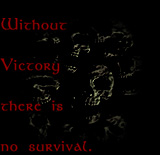|
|
|
|
|
|
|
|
|
|||
 |
||||||||||
|
|
|
|||||||||
 |
|
|||||||||
|
|
||||||||||
|
On the Fringes
Man, Champions of
Kamigawa is only six days away from making its way
onto the tournament scene. So I know everyone is
going around now trying to build new decks. There is
a lot of information around the internet right now.
There are a lot of decks and deck ideas floating
around.
But, I get a lot of e-mails from readers saying they don't want to copy decks and that they want help with decks. That's all fine and good. When you get decks from the internet, it's not all bad. Those decks have been battle tested. That saves you a ton of time. Also, it you aren't a great deck builder, it can save you a ton of effort. But what about those of you that DO want to build your own decks? OK, I might be able to help a little. The first things to understand though is that there is no true secret to deckbuilding. There are a lot of things to consider. What sets many of the good builders apart is the ability to find the critical cards. More importantly, it's figuring out how many slots they critical cards need. These are the cards on the fringes when you are deck building. For instance, cards like Kumano, Master Yamabushi is a perfect example. This card has the ability to deal one damage to a creature or player with a small activation cost of 1R. Also, if he manages to kill a creature this way, it's removed from the game instead of put into the graveyard. It also costs five mana. So this is a hard one to fit. It's a strong 4/4 body, and can help you hold up the fort. A card like this has multiple functions though. It attacks and blocks. Its can help finish the opponent. It can break up small creature fronts. It's actually rather good. And before you dismiss it, think about the fact that people play with Arc Slogger. But he's also a legend. If you review my article from two weeks ago, this was a big issue. A card like this has a hard time making four slots in a deck. And honestly, I'd be leaning more toward three. But, with Kumano retaining his legendary status, I can only go with two copies. This is mainly because a card this versatile really demands more than one copy in a deck. Let's look at another example. Something in the way of Call to Glory can be key to a deck as well. The ability to untap all creatures you control AND on top of that have samurai you control get +1/+1 until end of turn is just great. And it's cheap to cast. The problem is that it truly isn't that great ALL the time. Again, this is another card that doesn't merit the use of four copies in a deck. How horrible would it be to draw this up with one or less creature on the table. Honestly, it wouldn't even be that great if you were playing against a control deck with very few creatures either. Then untapping your guys doesn't have as strong of an effect. So in some cases you wouldn't want any of them. But then again, if your deck included a lot of samurai creatures this card might retain even more value. However, if you think outside the box on more practical issues, if you were using this in a combo deck that required creature tapping, this could be useful. So in regular creature decks, probably two. In samurai heavy decks, you could go with three. And in combo decks, you could possibly play four depending on the deck. A spell like Counsel of the Soratami is pretty straight forward. You pay three mana and draw two cards. Of course, it's a sorcery. But regardless, I would imagine most blue decks or control deck would want to play three or four copies of this card. Draw two cards is always good. It's a very hard deal to argue with. So, there are few situations where you want less. This was an easy one to figure out. Glacial Ray is one that seems to be on the fringes for me. I'm unsure if it if good enough to play. It intrigues me though because of the splice onto arcane ability it has for such a cheap cost. My best guess on a card like this, would be to play only three if there were a LOT of arcane spells in the deck. The logic is simple. Since it's cost and it's SoA ability is the same, you will likely be splicing more often than casting it, so drawing two of them up doesn't help a whole lot. But, if you are playing very few of them in the deck, that could change things a bit. Then you'll want the spell for a possible chance to splice it, but more for a chance to blast an opponent or creature at a key moment. OK, here's one last one to observe. Glimpse of Nature has an ability that really draws me toward the card. This is going to be really great in a combo based deck that can use creatures to load it's hand and redraw. Outside of that though, what do you truly want to do with it. I think this is obviously a card you don't want four of in a deck. It doesn't do you any good really to have multiples of these in your hands. Once you've blown your creature supply in hand, you're done. Unless of course you draw a ton more from it, but that's a whole other thing to consider. It might be a good sideboard card against control heavy decks. The popular strategy against Wrath of God and other similar spells is to just play one or two creature at a time and wait for them to be dealt with. Well, after a large board sweeper, you can now play Glimpse of Nature followed by two or three creatures. It sort of evens things up a little. At best, this card gets two slots. When I good combo deck rolls around, that would be the only time I'd expect to see four cope in a deck. That's a large variety of cards. And that shows you why they can all be important. As you can see above though, the same card applied to different decks and concepts warrants a different number of copies in each deck. There are a lot of factors to consider. What does this all ultimately mean to you? I don't know. I'm just hoping to open your eyes to possibilities. I want the readers to be able to look at this and apply some of the same logic to their deckbuilding. Again, there's no ultimate secret to deck building. There are a lot of little things to learn and this is just one o them. Some players possess a natural skill to build decks. That's great for them. It's the same an a person that's a natural born athlete. However, the rest of us need to bust our butts and learn a bit to be good at it. Personally, I think I build reasonably decent decks. I also enjoy it though, and I'm sure that has a lot to do with it. For those of you that enjoy building your own decks, I hope this was helpful and useful. Until next time, DeQuan Watson a.k.a. PowrDragn PowrDragn at Pojo dot com
|
|||||||||

